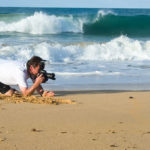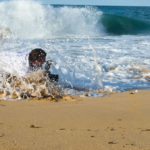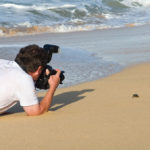I recently returned from a fantastic three-week trip to Panama, where we photographed critically endangered sea turtles like the Leatherback and Hawksbill as well as lots of other wildlife. We were there during the rainy season, so overcast skies and daily showers were not uncommon, although showers occurred more frequently at night. The potential impact of rain showers and humidity on equipment has always been a concern of mine when working in the tropics, even going back to my Nikon F3 days, when the biggest problem was condensation within lenses. There were times when it would take 2 – 3 hours for my 400mm f2.8 or 17-35mm lenses to “clear up” in the morning when camping in the Osa Peninsula of Costa Rica. But in general, everything always kept working. Wow, how things have changed in the digital era!
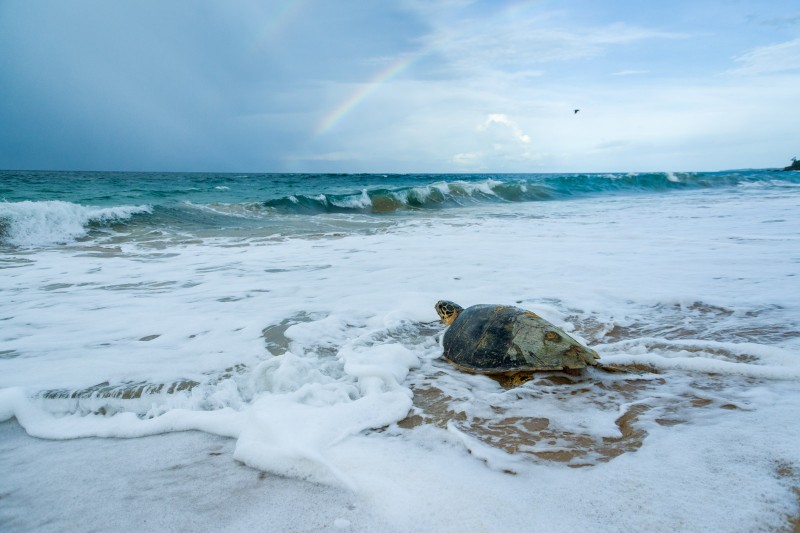
A critically endangered Hawksbill Sea Turtle (Eretmochelys imbricata imbrica) returning to the sea after nesting on the beach. (Bocas del Toro, Panama) ©2012 Rich Wagner | WildNaturePhotos
Near the end of our trip to Panama, while shooting hatchling Hawksbill sea turtles that were crawling quickly down the beach and out to sea, I was unexpectedly struck by a large wave. (The surf was huge at times – there were some world-class surfers there for a few days of filming.) I shielded the camera with my body, and not a drop of water hit the front lens element. Part of the splash did hit the camera body and lens as well as the SB-900 flash that was attached to the camera (used for shooting the hatchlings in the shade of trees near the nest site). I dried/shook off the water on the camera and kept shooting for another 20 minutes, until the D800E camera body went berserk. It started firing rapidly without touching the shutter release, and continued even after the camera was turned off. I quickly pulled the batteries to stop the shutter from firing and then continued to shoot with a backup D7000. The camera was wiped down with damp (freshwater) towels to remove any salt residue and then dried and packed away for return to NPS.
Here’s what the “event” looked like. By chance, Margie had stopped shooting turtle hatchlings for a moment and captured “The Wave.”
(Click to enlarge, back-arrow to return.)
After returning to the States, the camera was immediately shipped back to Nikon for anticipated cleaning and repair. One week later, the news:
“Service Repair Rank B2
REPAIR
BEYOND ECONOMICAL REPAIR. SEVERE WATER DAMAGE, CORROSION ON PG PCB, DC BACK COVER, TFT MONITOR, TOP COVER, HOT SHOE AND CCD AF SENSOR.”
Wow, a $3,300 camera, several weeks old, transformed into a brick? It looks fine!!! Apparently, the insides do not. An insurance claim was filed and the replacement D800E just arrived, thanks to NPS. Anyone looking for a slightly used but non-functional D800E, cheap??
This is certainly concerning, because although I have multiple camera/lens rain covers, not infrequently I get caught in a sudden, unanticipated downpour. Salt water is tough on equipment, but this seemed like a minimal exposure. In the previous week, the same camera with a 200mm Micro lens was nearly drenched by a sudden downpour while we photographed mating Red-eyed Tree Frogs. The sudden, unexpected downpour terminated the shoot. Fortunately, the camera and lens did not suffer any damage at that time, although everything did get wet.
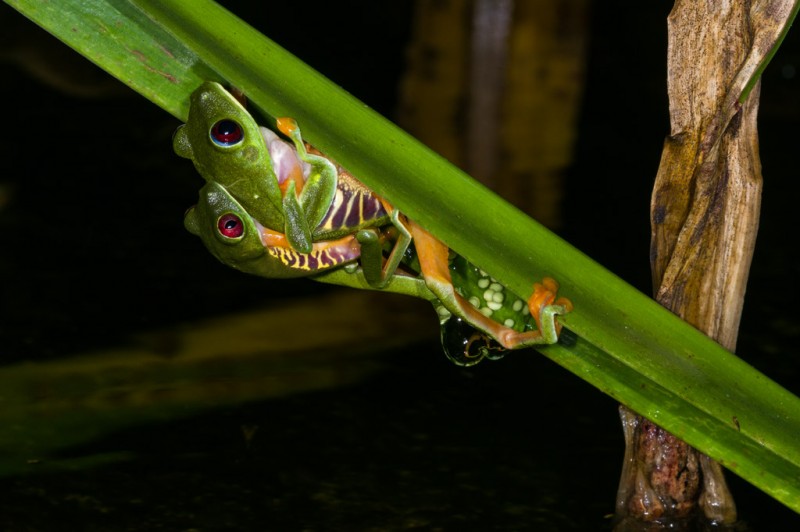
A mating pair of Red-eyed Tree Frogs (Agalychnis callidryas) in amplexus and laying eggs. The “bubble” is sperm from the male. (Bocas del Toro, Panama) ©2012 Rich Wagner | WildNaturePhotos
My impression is that the older “pro” Nikon camera bodies were better protected from the elements. Although the D800E is placed in the “advanced amateur” category by Nikon, a more weatherproof “pro” camera body that provides a comparable image does not yet exist. Therefore, be forewarned – the D800 is not weather-proof, and it is certainly not water-resistant. I do hope that Nikon will improve the weatherproofing of high-end cameras with future models. Even so, the D800E is a great camera, and I’m glad to have a replacement so quickly.
Tags: D800E, Endangered Species, Nikon D800E, Panama
